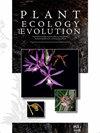坦桑尼亚22种芦荟的保护现状修正和群落认知
IF 1.1
4区 生物学
Q3 PLANT SCIENCES
引用次数: 2
摘要
背景和目的-由于贸易和栖息地破坏的过度采伐,许多芦荟物种在全球受到威胁。CITES规范了它们的国际贸易。在坦桑尼亚,所有现有芦荟物种的50%以前已进行了评估,尽管其中一些评估数据不足。对于那些有足够数据的人来说,由于过去几年下降的速度迅速增加,需要进行更新。材料和方法-我们使用地理空间保护评估软件(GeoCAT)估计了22种坦桑尼亚芦荟的占用面积(AOO),发生范围(EOO)和位置数量。我们根据直接的实地观察和社区的看法评估了导致它们下降的原因。修订了22种芦荟的保护现状;其中2只被评估为“极度濒危”,10只被评估为“濒危”,5只被评估为“脆弱”,5只被评估为“最不关注”。我们重新发现了极度濒危的boscawenii芦荟,这种植物在坦桑尼亚已经60多年没有出现过了。我们建议将特种芦荟(Aloe dorotheae)、芦荟(Aloe leptosiphon)和芦荟(Aloe flexilifolia)从“极度濒危”降至较低的威胁级别。群落对芦荟物种可得性的认知不能准确反映基于IUCN标准b的分类。我们确定农业活动和气候变化影响是对坦桑尼亚芦荟物种的两个主要威胁。结论-我们得出结论,坦桑尼亚22种芦荟的总体数量正在下降,主要是由于人类活动。我们建议实施法律和政策来保护它们的自然栖息地。本文章由计算机程序翻译,如有差异,请以英文原文为准。
Conservation status revision and communities’ perceptions of 22 Aloe species in Tanzania
Background and aims – Many Aloe species are globally threatened due to overharvesting for trade and habitat destruction. CITES regulates their international trade. In Tanzania, 50% of all existing Aloe species had previously been assessed, though some of these assessments were Data Deficient. For those with sufficient data, an update is required as the rate of decline has rapidly increased over the last years. Material and methods – We estimated Area of Occupancy (AOO), Extent of Occurrence (EOO), and number of locations for 22 Tanzanian Aloe species using the Geospatial Conservation Assessment software (GeoCAT). We assessed the reasons leading to their decline based on direct field observations and community perceptions. Key results – We revised the conservation status of 22 Aloe species; two were assessed as Critically Endangered, ten as Endangered, five as Vulnerable, and five as Least Concern. We re-discovered the Critically Endangered Aloe boscawenii, which had not been seen in Tanzania for more than six decades. We propose to downgrade the endemic Aloe dorotheae, Aloe leptosiphon, and Aloe flexilifolia from Critically Endangered to a lower threat level. The community perception on Aloe species availability did not accurately reflect their categorisation based on the IUCN criteria B. We identified agricultural activities and climate change effects as the two main threats to Tanzanian Aloe species.Conclusion – We conclude that overall numbers are declining for 22 Aloe species in Tanzania, mainly due to human activities. We recommend the implementation of laws and policies to protect their natural habitats.
求助全文
通过发布文献求助,成功后即可免费获取论文全文。
去求助
来源期刊

Plant Ecology and Evolution
PLANT SCIENCES-
CiteScore
2.20
自引率
9.10%
发文量
27
审稿时长
>12 weeks
期刊介绍:
Plant Ecology and Evolution is an international peer-reviewed journal devoted to ecology, phylogenetics and systematics of all ‘plant’ groups in the traditional sense (including algae, cyanobacteria, fungi, myxomycetes), also covering related fields.
The journal is published by Meise Botanic Garden and the Royal Botanical Society of Belgium.
 求助内容:
求助内容: 应助结果提醒方式:
应助结果提醒方式:


